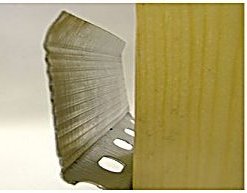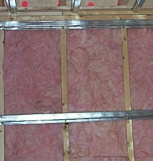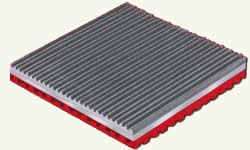Problem: Noise intrusion from an adjoining apartment or room
Cause: A deficiency in the common or adjoining party wall
Solutions:
- Build the wall as two or more separate layers. The heavier the layers, the better the noise reduction. Very dense materials, such as steel or lead, give weight with minimum thickness. Such unusual materials are used in a wall only if the sound barrier must be kept thin.
- Eliminate solid contact between the layers. Where connections are needed, they must be resilient. An air space, resilient metal furring, rubber, steel springs, or cushioning blankets are used to reduce vibration transmission between one side or layer of a wall or floor and the next as shown in Figures 1a, 1b and 1c.

Figure 1a - Resilient Bar

Figure 1b - Resilient Bars On Walls and Ceiling

Figure 1c - Neoprene Pad Reduces Noise Transmission
- Make the cavity as deep as practical. A thin air space can transmit too much vibration from layer to layer.
- Reduce party-wall leaks created by installing back-to-back electrical boxes instead of offsetting them by at least 16 inches (400 mm) and be sure fibrous insulation fills in behind them so that leaks do not lead directly to the air space. Sealed air-vapor-barrier electrical boxes designed for exterior walls are ideal for sound-barrier walls.
- Call in an acoustical consultant for STC testing and advise.
Additional information on noise retardant wall construction
